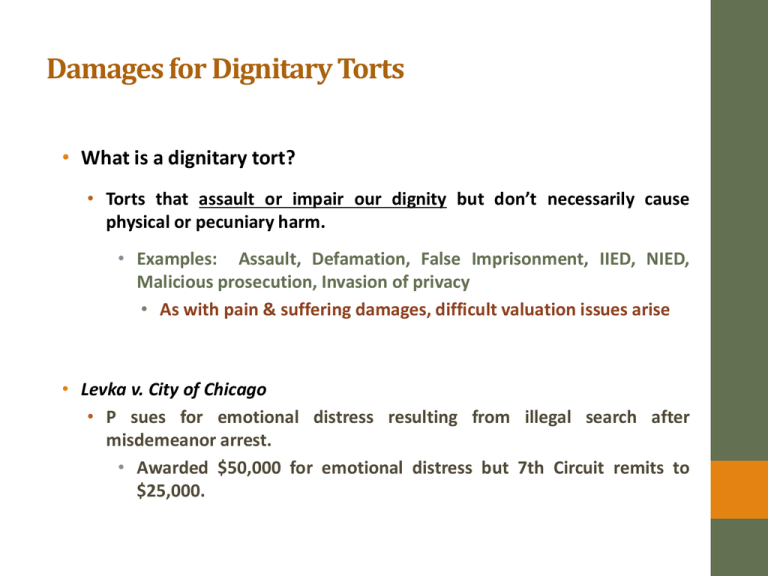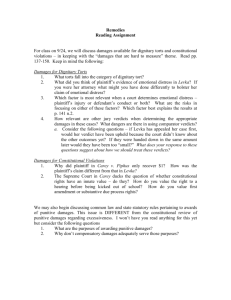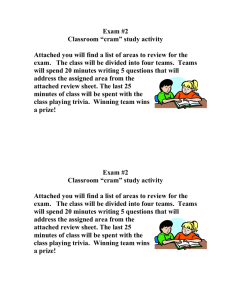9/24
advertisement

Damages for Dignitary Torts • What is a dignitary tort? • Torts that assault or impair our dignity but don’t necessarily cause physical or pecuniary harm. • Examples: Assault, Defamation, False Imprisonment, IIED, NIED, Malicious prosecution, Invasion of privacy • As with pain & suffering damages, difficult valuation issues arise • Levka v. City of Chicago • P sues for emotional distress resulting from illegal search after misdemeanor arrest. • Awarded $50,000 for emotional distress but 7th Circuit remits to $25,000. What could Levka ’ s attorney have done differently to convince the appellate court of her emotional distress? • Focus on plaintiff’s harm • Emphasize particular frailty • Reframe inferences court drew from evidence • Bolster psychological evidence • Focus on defendant’s conduct • Try to frame it as more outrageous than court characterized it How courts generally approach damages with dignitary torts: In these types of torts, courts generally attempt to gauge damages in light of the two factors we just discussed: 1) Plaintiff’s injury (especially if particular frailty) and 2) Defendant’s conduct (how outrageous?) • These are applied as a sliding scale • Are there problems w/ focusing on D’s conduct? • Are there problems w/ focusing on P’s frailties? How relevant are other jury verdicts to determining “excessiveness”? o Levka court used “remittitur” – a practice where district or appellate courts order a reduction in damages because they are “grossly excessive.” • Most courts use remittitur at some point and they have a lot of discretion. • Court usually gives the option of a new trial so P can choose between new trial and reduction of damages. • See Mo SCT Rules 78.10 Remittitur and Comparator Verdicts o Some courts, like Levka, are starting to use comparator verdicts to make remittitur decisions (i.e., re whether a particular decision is grossly excessive). o Are such verdicts relevant to the issue of excessiveness? o What kind of mathematical precision do we want judges to engage in here? Damage awards for constitutional violations – the rule in Carey v. Piphus o Why does P only get $1 in damages? o Why won’t SCT presume damages for a procedural due process violation (or for any constitutional violation for that matter)? o What kind of damages could P try to recover? The Value of Constitutional Rights? • The Court dances around the question of whether constitutional rights have an innate value – do they? • If so, shouldn’t we compensate for the mere violation of a right? • What issues arise if we compensate for a right violation without actual damages (like those the plaintiff suffered in Levka)? • Note that SCT takes same approach in Stachura (p. 149 n.1) that it did in Carey v. Piphus. Goals of Punitive Damages • Punishment • Notions of public morality and “just deserts” require that Ds “pay” for their bad actions • Deterrence • Compensatory damages, criminal sanctions and/or government safety standards don’t sufficiently deter the conduct at issue so punitive damages are necessary. • Focus is on D’s behavior not P’s losses Why don’t compensatory damages, criminal fines, safety standards sufficiently deter? • Difficulty of measuring some damages may cause under-compensation & under deterrence • Some wrongs are small but nevertheless outrageous (damage awards may not deter) • E.g., Levka – strip search of all female arrestees • Some behavior is extremely profitable (beyond awards of compensatory damages) • Some Ds profit in ways that compensatory damages can’t account for – i.e., pleasure at causing another pain • Criminal fines are usually quite small (even smaller than compensatory awards) • Safety standards are often not enforced by administrative officials & fines are often small






